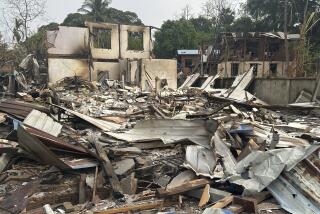Saving Burma the right way
Iwas 8 when I experienced my first protests in Burma. It was 1974, and thousands of students and Buddhist monks had taken to the streets, angered by the military governmentâs handling of burial arrangements for my grandfather, U Thant, the former United Nations secretary-general.
I was born in New York, and it was my first trip to Rangoon. I remember well the flood-lit pagodas and crumbling colonial buildings, the faces of the young in the crowds as they pressed up against our car, and the scrawny soldiers slinging their automatic weapons, only days before they would fire them on unarmed civilians. Hundreds were eventually killed or arrested.
When the next, much bigger uprising took place in 1988, I was 22. These protests too were crushed, with even greater violence; hundreds, perhaps thousands, were left dead. Iâm now 41, and as I watched the recent demonstrations by Buddhist monks on television, I couldnât help but feel a certain inevitability about the way things were going to turn out.
I have a nightmare scenario for Burma. It goes something like this: Iâm about 60, and there is still a military regime. One day, students and monks again lead mass protests. This time they are successful. The army leadership caves in, and the regime falls to pieces. There is, however, almost nothing left to build on. Western sanctions, tightened over the years, have had no real effect on the governmentâs politics, but they have frozen out Western influence and the potential benefits of globalization. The country is poorer than ever. The healthcare and education systems have disintegrated, and there is no alternative political leadership nor even an educated class of technocrats who can keep basic state institutions intact.
The long-running insurgencies in the hills have largely petered out, but there is no real peace, only simmering inter-ethnic grievances and armed gangs in place of the former rebel armies. India and China are powerful and prosperous, and Burma is a basket case, having traded the countryâs natural wealth for what few consumer goods it could afford. The uprising is successful, but it leads to chaos and anarchy. Burma becomes a failed state, a disaster zone in an otherwise rich and happy Asia.
Could such a scenario come to pass? Itâs not impossible. Indeed, as recent Burmese history shows, the country may already be on its way there.
When Burma (renamed Myanmar by the junta) achieved independence from Britain in 1948, the country was already at civil war. A widespread communist insurgency attempted to seize power, the army splintered along ethnic lines, and much of the countryside fell under the control of local militia. The then-democratic government barely survived. In the early 1950s, Chinese nationalist forces, supported by the CIA, marched in from the east (remnants of the armies of Chiang Kai-shek), and in the 1960s, Beijing backed a massive new communist rebellion.
To fight these different foes, a big military machine grew up, which soon outclassed and outgunned every other part of the nascent state. By 1962, the army took over entirely. At its head was Gen. Ne Win, tyrant, playboy, numerologist and onetime post office clerk, a tough-talking, Japanese-trained soldier who would wield absolute power for the next 30 years.
His âBurmese way to socialismâ quickly ran the once-promising economy into the ground. He nationalized all industries, banned international trade and investment, expelled nearly half a million ethnic Indians and stopped accepting foreign aid. He shut off Burma from the rest of the world but made an exception for himself, hobnobbing with British aristocrats in London, shopping in Geneva and (for a while, perhaps not long enough), traveling regularly to Vienna to consult the well-known psychiatrist, Dr. Hans Hoff.
Burma is about the size of France and Britain combined, with a population of more than 50 million, stretching from the eastern Himalayas 1,000 miles south to sun-drenched beaches along the Andaman Sea. About two-thirds of the people are Burmese Buddhists; the rest belong to dozens of other ethnic and religious groups. Members of the army under Ne Win began to see themselves as Burmaâs saviors -- from foreign aggression and internal fragmentation -- looking backward to the glory days of Burmese warrior-kings and tapping into Burmese nationalismâs more xenophobic strains.
The country only began to crawl out of its isolation in the early 1990s, when the regime finally began to welcome foreign trade and investment back to the country and asked for help in reforming the economy. As important, the army agreed to cease-fires with nearly all the various rebel armies. But all this came at the same time that Burmaâs new democracy movement -- headed by Aung San Suu Kyi, the daughter of a revered hero of the Burmese independence movement who had been assassinated -- was pressing hard for political change. The West began to impose sanctions to support her position, pushing the generals back into their shell.
And so the stage is set for an even worse turn in the future. We have seen the anger and frustration on the streets of Rangoon (now called Yangon by the junta). The cease-fires remain fragile, but the international community has done little or nothing to encourage moves toward a just and sustainable peace. There is the dire poverty. And there is the fragility of the state itself. In Burma, the army has become the state -- there is little else. And yet the present officer corps, having grown up in international isolation, has little sense of the alternatives and remains deeply distrustful of the outside world.
There is still time to avoid the nightmare, but Iâm afraid it will take a lot more than the international community is likely to give. Avoiding disaster will require high-level attention and commitment beyond the couple of weeks when Burma is on the newspaper front pages and television screens. It will require an acceptance that long-distance condemnation and Western economic sanctions donât mean much to the half-century-old military regime, a regime that has long been comfortable in isolation and needs only a modicum of money and trade from the outside world. It will require a realization that Burma sits right in the middle of Asiaâs economic miracle, that harnessing Burma to that rapid change is the surest way to raise up living standards, and that access to Western markets and Western ideas will make all the difference in determining whether the Burmese become equal partners of China and India or merely the providers of cheap labor and raw materials. And itâs only when the Burmese ruling elite are exposed to the world that they will see a need to mend their ways.
Avoiding disaster in Burma will mean taking a long-term and pragmatic approach and understanding that democracy wonât be created overnight. Cooperation among the United States, China and India will be essential, but it cannot be based on a policy of âregime change.â We need to see the bigger picture in Burma -- not only the protests and the repression but also the ethnic conflicts, the pressing need to reform the economy and the urgency of delivering assistance to the most vulnerable people, especially the children. The war, poverty and repression are all interlinked; progress on all these fronts needs to happen together.
This is not an easy sell. After the images televised over the last few weeks, itâs easy to reach for more sanctions and look for any possible way to clobber the Burmese junta. But with a new realism on the part of the international community and fresh, results-oriented policies, Burma may still be saved from the nightmare to come.
Thant Myint-U is the author of âRiver of Lost Footsteps: Histories of Burma.â
More to Read
A cure for the common opinion
Get thought-provoking perspectives with our weekly newsletter.
You may occasionally receive promotional content from the Los Angeles Times.










